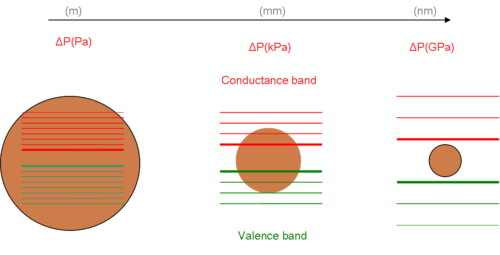
Potential well
Encyclopedia

Potential energy
In physics, potential energy is the energy stored in a body or in a system due to its position in a force field or due to its configuration. The SI unit of measure for energy and work is the Joule...
. Energy captured in a potential well is unable to convert to another type of energy (kinetic energy
Kinetic energy
The kinetic energy of an object is the energy which it possesses due to its motion.It is defined as the work needed to accelerate a body of a given mass from rest to its stated velocity. Having gained this energy during its acceleration, the body maintains this kinetic energy unless its speed changes...
in the case of a gravitational potential well) because it is captured in the local minimum of a potential well. Therefore, a body may not proceed to the global minimum of potential energy, as it would naturally tend to due to entropy
Entropy
Entropy is a thermodynamic property that can be used to determine the energy available for useful work in a thermodynamic process, such as in energy conversion devices, engines, or machines. Such devices can only be driven by convertible energy, and have a theoretical maximum efficiency when...
.
Overview
Energy may be released from a potential well if sufficient energy is added to the system such that the local minimum is surmounted. In quantum physics, potential energy may escape a potential well without added energy due to the probabilisticProbability
Probability is ordinarily used to describe an attitude of mind towards some proposition of whose truth we arenot certain. The proposition of interest is usually of the form "Will a specific event occur?" The attitude of mind is of the form "How certain are we that the event will occur?" The...
characteristics of quantum particles; in these cases a particle may be imagined to tunnel through the walls of a potential well.
The graph of a 2D potential energy function is a potential energy surface
Potential energy surface
A potential energy surface is generally used within the adiabatic or Born–Oppenheimer approximation in quantum mechanics and statistical mechanics to model chemical reactions and interactions in simple chemical and physical systems...
that can be imagined as the Earth's surface in a landscape of hills and valleys. Then a potential well would be a valley surrounded on all sides with higher terrain, which thus could be filled with water (i.e., be a lake
Lake
A lake is a body of relatively still fresh or salt water of considerable size, localized in a basin, that is surrounded by land. Lakes are inland and not part of the ocean and therefore are distinct from lagoons, and are larger and deeper than ponds. Lakes can be contrasted with rivers or streams,...
) without any water flowing away toward another, lower minimum (i.e. sea level
Sea level
Mean sea level is a measure of the average height of the ocean's surface ; used as a standard in reckoning land elevation...
).
In the case of gravity, the region around a mass is a gravitational potential well, unless the density of the mass is so low that tidal force
Tidal force
The tidal force is a secondary effect of the force of gravity and is responsible for the tides. It arises because the gravitational force per unit mass exerted on one body by a second body is not constant across its diameter, the side nearest to the second being more attracted by it than the side...
s from other masses are greater than the gravity of the body itself.
A potential hill is the opposite of a potential well, and is the region surrounding a local maximum.
Quantum confinement

The quantum confinement effect can be observed once the diameter of the particle is of the same magnitude as the wavelength of the electron wave function. When materials are this small, their electronic and optical properties deviate substantially from those of bulk materials.
A particle behaves as if it were free when the confining dimension is large compared to the wavelength of the particle. During this state, the bandgap remains at its original energy due to a continuous energy state. However, as the confining dimension decreases and reaches a certain limit, typically in nanoscale, the energy spectrum
Spectrum
A spectrum is a condition that is not limited to a specific set of values but can vary infinitely within a continuum. The word saw its first scientific use within the field of optics to describe the rainbow of colors in visible light when separated using a prism; it has since been applied by...
turns to discrete
Discrete
Discrete in science is the opposite of continuous: something that is separate; distinct; individual.Discrete may refer to:*Discrete particle or quantum in physics, for example in quantum theory...
. As a result, the bandgap becomes size dependent. This ultimately results in a blue shift in optical illumination as the size of the particles decreases.
Specifically, the effect describes the phenomenon resulting from electrons and electron holes being squeezed into a dimension that approaches a critical quantum
Quantum
In physics, a quantum is the minimum amount of any physical entity involved in an interaction. Behind this, one finds the fundamental notion that a physical property may be "quantized," referred to as "the hypothesis of quantization". This means that the magnitude can take on only certain discrete...
measurement, called the exciton
Exciton
An exciton is a bound state of an electron and hole which are attracted to each other by the electrostatic Coulomb force. It is an electrically neutral quasiparticle that exists in insulators, semiconductors and some liquids...
Bohr radius
Bohr radius
The Bohr radius is a physical constant, approximately equal to the most probable distance between the proton and electron in a hydrogen atom in its ground state. It is named after Niels Bohr, due to its role in the Bohr model of an atom...
. In current application, a quantum dot
Quantum dot
A quantum dot is a portion of matter whose excitons are confined in all three spatial dimensions. Consequently, such materials have electronic properties intermediate between those of bulk semiconductors and those of discrete molecules. They were discovered at the beginning of the 1980s by Alexei...
such as a small sphere confines in all three dimensions, a quantum wire
Quantum wire
In condensed matter physics, a quantum wire is an electrically conducting wire, in which quantum effects are affecting transport properties. Due to the quantum confinement of conduction electrons in the transverse direction of the wire, their transverse energy is quantized into a series of...
confines in two dimensions, and a quantum well
Quantum well
A quantum well is a potential well with only discrete energy values.One technology to create quantization is to confine particles, which were originally free to move in three dimensions, to two dimensions, forcing them to occupy a planar region...
confines in one dimension. These are also known as zero-, one- and two-dimensional potential wells, respectively. In these cases they refer to the number of dimensions in which a confined particle can act as a free carrier. See external links, below, for application examples in biotechnology and solar cell technology.
Quantum mechanics view
Τhe electronic and optical properties of materials are affected by size and shape. Well-established technical achievements including quantum dots were derived from size manipulation and investigation for their theoretical corroboration on quantum confinement effect. The major part of the theory is the behaviour of the excitonExciton
An exciton is a bound state of an electron and hole which are attracted to each other by the electrostatic Coulomb force. It is an electrically neutral quasiparticle that exists in insulators, semiconductors and some liquids...
ensembles more like an atom as its surrounding space shortens. A rather good approximation of an exciton’s behaviour is the 3-D model of a particle in a box
Particle in a box
In quantum mechanics, the particle in a box model describes a particle free to move in a small space surrounded by impenetrable barriers. The model is mainly used as a hypothetical example to illustrate the differences between classical and quantum systems...
. The solution of this problem provides a sole mathematical connection between energy states and the dimension of space. It is obvious that decreasing the volume or the dimensions of the available space, the energy of the states increase. Shown in the diagram is the change in electron energy level and bandgap between nanomaterial and its bulk state.
The following equation shows the relationship between energy level and dimension spacing:


Research results provide an alternative explanation of the shift of properties at nanoscale. In the bulk phase, the surfaces appear to control some of the macroscopically observed properties. However in nanoparticles, surface molecules do not obey the expected configuration in space. As a result, surface tension changes tremendously.
Classical mechanics view

The Young-Laplace equation can give a background on the investigation of the scale of forces applied to the surface molecules:

Under the assumption of spherical shape R1=R2=R and resolving Young Laplace equation for the new radii R(nm) we estimate the new ΔP(GPa). The smaller the R, the greater the pressure it is. The increase in pressure at the nanoscale results in strong forces toward the interior of the particle. Consequently, the molecular structure of the particle appears to be different from the bulk mode, especially at the surface. These abnormalities at the surface are responsible for changes of inter-atomic interactions and bandgap.

